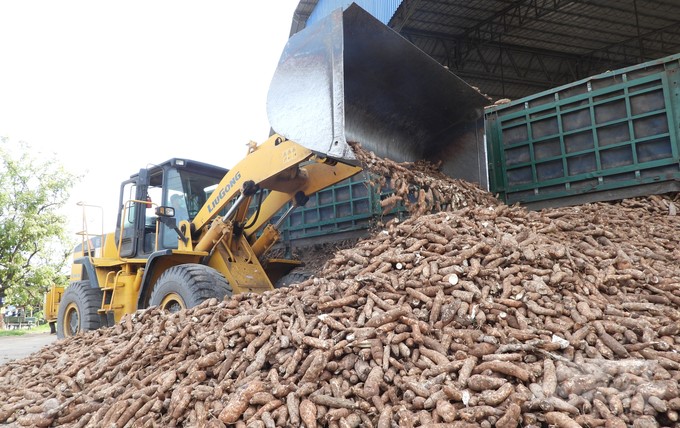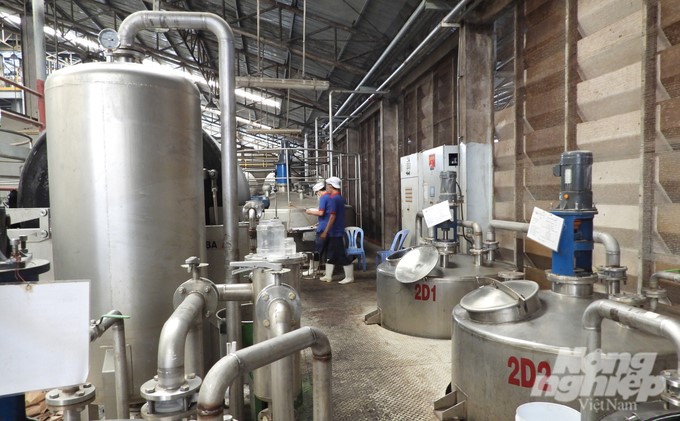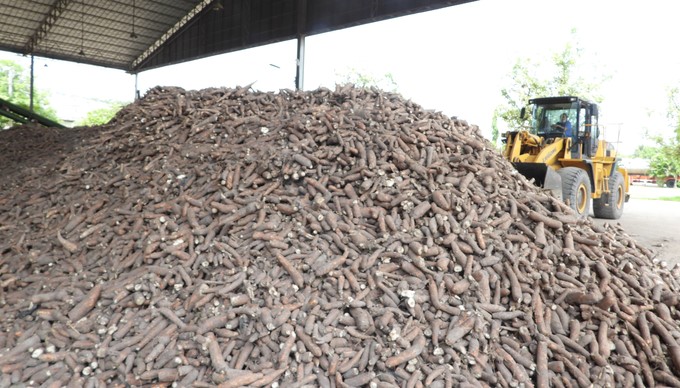December 7, 2025 | 18:55 GMT +7
December 7, 2025 | 18:55 GMT +7
Hotline: 0913.378.918
December 7, 2025 | 18:55 GMT +7
Hotline: 0913.378.918
Tay Ninh has a cassava growing area of more than 61,000 hectares, ranking second in the country with always high starch content and an annual output of over 2 million tons. In addition, the whole province has more than 68 cassava starch processing factories, with a total capacity of over 6.4 million tons of tubers/year. Tay Ninh is known as the center of the cassava starch processing industry in the country.

Tay Ninh is known as the center of the cassava starch processing industry in the country. Photo: Tran Trung.
It is estimated that a processing factory with a capacity of 30–100 tons/day will produce 7.5–25 tons of starch, accompanied by 12–48 tons of cassava residue. According to scientists, cassava residue has low dry matter content (about 20%), very poor protein (1.5–1.6%), low fiber content (10–11%), and a very high digestibility rate of organic matter (92–93%). Therefore, the metabolizable energy value reaches 13 MJ/kg dry matter, which is food providing good energy for cattle and poultry. For a long time, cassava products in Tay Ninh have not only stopped at starch processing, but all by-products from cassava trees have been salvaged.
As one of the leading enterprises in the cassava starch processing industry in Tay Ninh province, each year, Dinh Khue Company Limited in Suoi Day commune, Tan Chau district, creates more than 3,500 tons of cassava residue. With the criterion "Business must be profitable and farmers and workers must benefit," Dinh Khue has promoted investment in technology, turning what was once considered a waste product into a significant source of revenue.

Dinh Khue has promoted investment in technology, turning cassava residue into a significant source of revenue. Photo: Tran Trung.
Ms. Nguyen Thi Khue, Director of Dinh Khue Company Limited, said that before 2018, the company mainly used old technology. Facing the increasing quality requirements of importers, the company boldly changed the entire machinery system to German and Swedish technology and standardized products according to international standards. Thanks to strong investment, the enterprise's production system now operates in a closed circulation direction without discarding any waste products and by-products from cassava.
"The trend of shifting production from 'brown' to 'green' has been becoming a global trend, and for the cassava starch production industry in general, Dinh Khue is also not an exception," Ms. Khue shared.
Currently, the company's processing capacity reaches about 280 tons of fresh cassava/day. During the production process, from input raw materials of fresh cassava to stages such as peeling, washing, chopping, grinding, separating residue, condensing starch, separating water, and packaging finished products, all are operated in a closed chain.
Accordingly, the company has built a biological wastewater treatment system combining the physical and chemical properties of activated sludge and anaerobic-anoxic-aerobic biotechnology. For the amount of cassava residue discharged from the processing process, accounting for about 45%, the company invests in a methane recovery system and takes advantage of this biogas energy source to burn the boiler and dry the cassava residue.
"In the past, cassava residue, after all the starch had been removed, became a waste product, causing environmental pollution. But today, cassava residue is a significant source of revenue for enterprises. With 3,500 tons of cassava residue, the business earned more than VND 6 billion. This is an extremely meaningful amount of money after the Covid-19 pandemic, when the price of cassava starch continuously decreased and most businesses suffered losses," Ms. Nguyen Thi Khue emphasized.

The salvage of by-products from the cassava starch processing industry has been encouraged by Tay Ninh province. Photo: Tran Trung.
According to Mr. Nguyen Dinh Xuan, Director of the Tay Ninh Department of Agriculture and Rural Development, cassava is the province's "strong" crop. While the economy is facing difficulties and lacking energy and fuel, the salvage of by-products from production to create on-site energy sources should be encouraged.
Currently in Tay Ninh province, not only Dinh Khue Company Limited but also most cassava processing enterprises in the province have reached processing levels, machinery, equipment, and technology equivalent to those in the world. The proof is that the world's most modern machinery and equipment are present in Tay Ninh.
"With the potential of agricultural waste products and by-products being awakened, in the coming time, the continuous chain of production, consumption, and utilization of agricultural waste products and by-products will bring more useful economic values while actively contributing to protecting the environment and land," Mr. Nguyen Dinh Xuan emphasized.
Translated by Thu Huyen
/2025/12/01/2936-2-222331_70.jpg)
(VAN) Mortgaging his house and giving up a pharmaceutical management career, Mr. Nguyen Quang Duy succeeded in bringing Khanh Hoa's sea grapes to demanding markets such as Japan and the U.S.

(VAN) The large-scale agroforestry investment project aims to develop a leading sustainable agro-industrial center in Angola.
/2025/11/28/3433-1-212821_213.jpg)
(VAN) Many localities across the coconut land of Vinh Long are replicating emission-reducing models in production and daily life, contributing to the targets for emission reduction and green economic development.

(VAN) The green transition is an inevitable path for collective economy to achieve balanced growth and align with global trends.

(VAN) The TH Group is not only Vietnam’s leading clean-milk producer; it is also leaving a strong mark on sustainable development as it pursues the goal of carbon neutrality.
/2025/11/27/3830-1-152901_403.jpg)
(VAN) Dong Nai is developing its key crop areas, expanding planting area codes, and applying high technology to increase the value of agricultural products, aiming at a green and sustainable agriculture.

(VAN) Tay Ninh’s livestock sector is undergoing a major transformation, applying high-tech, closed-loop circular models to build sustainable value chains.